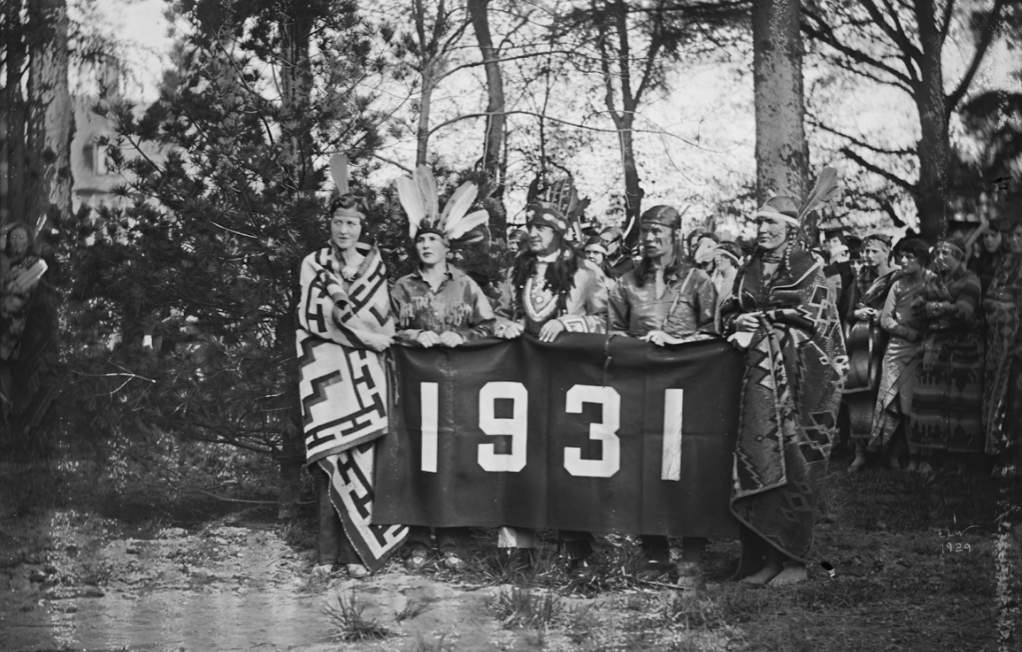Vassar’s class of 1867 chose to plant ivy at their “Class Day Celebration” but it died soon after its installation. This sparked the tradition of the Vassar Class Tree Ceremonies, as the class of 1868 made plans to plant a white swamp oak tree in front of Main building, instead of replacing the ivy. They planned a simple ceremony to commemorate the planting of this tree. This ceremony occurred in the evening of June 23, 1868, which wound up being the day of Matthew Vassar’s death, cementing the Tree Ceremony as a tradition which would go on to permeate through Vassar’s History. The silver spade which was used by Matthew Vassar to lay the first cornerstone of the College was used to break the land and would soon become an integral part of the ceremonial proceedings, as it would be formally passed on from the senior class planting their tree, to the junior class. This spade is still used to break the ground and plant class trees. The next year, the class of 1869 began the tradition of the senior class burying its records in the ground by the tree which soon became an integral part of the ceremony.
In 1877, the nature of the tree ceremony changed, as the class of 1879 began the tradition of the sophomore class’ new-found responsibility for the ceremony. The tree this class planted died in 1879 and the class “cremated” its tree and even put the ashes into an urn which was buried in the ground with the class’ records and a newly selected tree at the end of the year. The celebration shifted once more by 1884 because as opposed to being public, for all of Vassar’s student body as it once was, the Ceremony became closed off and reserved only for the Sophomore Class. This secrecy sparked a curiosity in freshmen, which added an unexpected theatricality to its nature. As freshmen continuously tried to infiltrate the ceremony, sophomores created increasingly elaborate ceremonies, in hopes of fooling the freshmen. The rites became more and more complex, as costumes were added, deceptive mock tree ceremonies were held, and doves were carried and set free. “The class of 1902 transformed themselves into ‘fire-lit Amazons’ with ‘flashing swords and gleaming helmets’ dancing around their tree at 4 a.m. The faculty tried to apply the brakes, ordering the next class of sophomores to post a notice of the time and place of their upcoming ceremonies 24 hours in advance. They ‘complied’ by putting up their notices ‘for several hours each night until they had a total of 24’”. 5 The ceremonies continued on in this rebelliously secretive manner, with students using this same method of secrecy and costuming themselves in various fashions, as animals, fairies, ghosts, skeletons, and more, until things changed once more.
In 1908, Vassar’s faculty changed the rules, making it so that the time and place of the ceremony had to be posted on public bulletin boards for at least 24 hours consecutively before the ceremony occurred. The class of 1909 was also the last class to bury its records at the base of their tree. This is probably to some degree because having to bury the records and bouquets of 250 girls became too large of an undertaking. With this change came a complete change in the attitude of the Class Tree Ceremony. There began to be what was said to be “‘A new sense of sacredness to the rites, [as] grotesque performances gave way to aesthetic and symbolic ceremonies’”. 6 The Poughkeepsie New Yorker describes the ceremonies as being “pretty arty,” with the example of the 1911 Ceremony including girls dressed in white and performing as the “veiled figures” of “Egyptian Sun Worshipers.” There is also a detailed description of the deeply symbolic 1913 ceremony with the girls dancing beneath their tree, joyously, “‘as maidens in rosy garments and garlands.’ However, the Spirit of the Tree waved them away with his sword until the class ‘had learned self control and peace through suffering’”. Once they “learned” this lesson of peace in the performance, “‘the Spirit of the Tree received the Class and became one with it’”. 7 Here, there began to be clear a sort of spiritual intention behind the ceremony. It is also seen how the students saw this ceremony as a part of their identity. The class was supposed to become one with the tree they were planting. They saw the tree as an important part of their class’ identity, as for the early years of the ceremony, there were even large monuments placed at the bases of the trees, noting which class the tree belonged to. This was another thing which had begun to change about the ceremony though, as Vassar’s administration thought that the campus was beginning to look too much like a graveyard.
